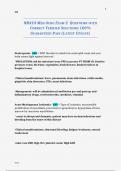1
NR
NR324 MED-SURG EXAM 2 QUESTIONS WITH
CORRECT VERIFIED SOLUTIONS 100%
GUARANTEED PASS (LATEST UPDATE)
Neutropenia - ANS ✓WBC Disorder in which low neutrophil count and your
body cannot fight against bacteria!
*PRECAUTION risk for infection! wear PPE to protect PT FROM US, Positive
pressure room, No fruits, vegetables, fresh flowers, limited visitors in
hospital room,
-Clinical manifestations: fever, pneumonia, sinus infections, ottitis media,
gingivitis, skin abscesses, UTIs, yeast infections
-Management: will be administered antibiotics pre and post op, anti-
inflammatory drugs, corticosteroids, cytokines, vitamins
Acute Myelogenous Leukemia - ANS ✓Type of Leukemia: uncontrolled
proliferation of myeoblasts, precursurs to granulocytes, hyperplasia of bone
marrow by cancerous myeloblasts:
* onset is abrupt and dramatic, patient may have serious infections and
bleeding from the onset of this disease
-Clinical manifestations: abnormal bleeding, fatigue/weakness, sternal
tenderness
-Labs: Low RBC, Hgb, Hct, platelet count; High LDH
NR324
, 2
NR
Chronic Myelogenous Leukemia - ANS ✓Type of Leukemia: caused by
excessive development of mature neoplastic granulocytes in bone marrow,
usually chronic stable phase that lasts for years then turns into an acute
aggressive phase that is often refractory to therapy
* 90% have philedelphia chromosomes . age of onset 25-60 year old
-Labs: Low RBC count, Hgb, Hct; High LDH, MRI, CT scan, Ultrasound
Acute Lymphocytic Luekemia - ANS ✓Type of Leukemia: most common type in
children, immature lymphocytes proliferate in bone marrow; most are B cell
origin, signs and symptoms may appear abruptly (fever and bleeding) or may be
insidious ( weakness, fatigue bleeding)
* 25% have Philadelphia chromosomes. age of onset between 2-14 year
olds
-Labs: Low RBC count, Hgb, Hct, platelet count, High LDH
-Management: radiation, stem cell transplant (curative) isolation room,
bone marrow transplant
Chronic Lymphocytic Leukemia - ANS ✓Type of Leukemia: most common type
in adults, characterized by production and accumulation of functionally inactive
but long-lived, small, mature-appearing lymphocytes, lymph node enlargement
throughout the body is present
* 50-70 year old onset
-Clinical manifestations: pain, paralysis from pressure caused by enlarged
lymph nodes, thrombocytopenia
NR324
, 3
NR
-Labs: mild anemia, total WBC count >100,000, increase in peripheral
lymphocytes and in bone marrow
-Management: chemotherapy, blood transfusion, bone marrow/stem cell
transplant
Hodgkins Lymphoma - ANS ✓WBC Disorder: malignant condition characterized
by proliferation of abnormal, giant, multinucleated cells called Reed-Sternberg
cells, located in lymph nodes
* B lymphocytes only - Reed-Sternburg cells
-Clinical manifestations: weight loss, fatigue/weakness, fever/chills, night
sweats, pruritus, dyspnea, stridor, dysphagia, jaundice
-Management: ABVD regimen, combination chemotherapy, manage pain
and side effects of therapy
Non Hodgekins Lymphoma - ANS ✓WBC Disorder: cancer of the lymphoid
tissue, which includes the lymph nodes, spleen, and other organs of the immune
system, all ages can be affected, most common occuring cancer, 5th leading cause
of cancer death
*B or T cell neoplasms only
-Clinical manifestations: painless lymph node enlargement, airway
obstruction, renal failure, pericardial pamponade, GI complaints, B
symptoms
-Labs: MRI, bone marrow, barium enema, upper endoscopy, CT, lymph node
biopsy
NR324




